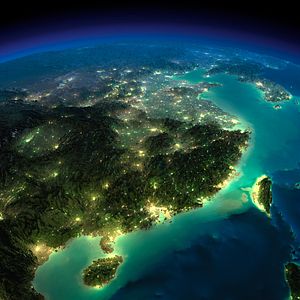Taiwan’s strong responses to the ruling of the Permanent Court of Arbitration (PCA) on the South China Sea, similar to China’s, may not be wise from a foreign policy standpoint, but the reaction highlights the undeniable linkage across the Taiwan Strait, a potential breakthrough in the cross-strait relations.
Since its democratization in the early 1990s, the political narrative of Taiwan gradually moved from a “free China” to a de facto state independent from China, despite keeping the same official title, the Republic of China (ROC). Although former President Ma Ying-jeou endeavored to promote cross-strait integration between 2008 and 2016, the subsequent landslide victories of Tsai Ing-wen and her Democratic Progressive Party (DPP), with their pro-independence inclincations, prove that the majority of voters favor the political separation or the so-called status quo. Under this position, Taiwan is supposed to act like an independent country, whether internationally recognized or not, with its own perspective rather than a Chinese one.
However, the South China Sea, one of the Chinese legacies from the ROC regime, saliently works in an opposite way. The ROC’s occupation of Itu Aba was established at the end of World War II, when the ROC government represented China. Right after the occupation, the ROC announced the eleven-dash line encircling the South China Sea, the basis for the nine-dash line later drawn by the subsequent Chinese regime, the People’s Republic of China (PRC). Thus, Itu Aba (or Taiping Island) is more than a remote place under Taipei’s control, but a clear sign of its unsettled relationship with Beijing. Such Chinese legacies in Taiwan are the main rationale for China’s sovereignty claim over Taiwan, including the ever-present possibility of using force. As a matter of its own survival, Taiwan should try to settle those Chinese legacies from the ROC, but the Tsai administration, despite the DPP holding a majority seats in the legislature, has not taken any major action.
Contrary to the conventional wisdom, the new DPP administration chose to emphasize this main Chinese legacy when the PCA ruling came. In addition to rejecting the ruling (such as the judgment that Itu Aba is not an island but a rock) and highlighting the ROC’s territorial claim over the South China Sea, including the eleven-dash line, Taipei even sent a naval frigate to the site. Those moves are similar to or even more assertive than Beijing’s.
The Tsai administration’s decision could be explained as a form of political populism, because public opinion in Taiwan usually demands governmental action to defend territories, including the Diaoyutai (Senkaku) Islands as well as Itu Aba. After being governed by the ROC regime for more than seven decades, the people in Taiwan have mainly accepted its Chinese legacies, especially when it comes to accessible territories. As the PRC has generally replaced the ROC in the international community, Taiwan is unable to take legal moves due to a lack of official recognition. Therefore, making a “show” of sending vessels to disputed areas is a tool for political leaders to comfort people, as evidenced in previous cases involving disputes with Japan and the Philippines. For the ROC’s political leadership, acting this way is quicker, easier, and safer than transforming Taiwan into a fully independent state with competent legal ability under international law. Thanks to overwhelming influence of mass media, the public’s short attention and memory makes this trick effective.
The Tsai administration probably made the decision out of similar considerations, and may have wanted to use aggressive moves to save its popularity after the embarrassing incident of a mistakenly launched anti-ship missile. Nevertheless its foreign affairs will suffer. Due to a high degree of economic dependence on China, the government’s “southbound policy” encourages Taiwanese business people to shift their investment and trade toward Southeast and South Asia in order to gain more economic balance. Rejecting the PCA ruling and taking a position similar to China’s may not directly to cause the southbound policy to fail, but the image of Taiwan as China’s “partner” and the expansive territorial claim will not help Taiwan explore commercial opportunities in Southeast Asian countries that have security concerns over the South China Sea.
However, Taiwan’s response to the ruling also presents an opportunity for cross-strait relations. Although Tsai Ing-wen separately used the words “1992” and “consensus” in her inauguration speech on May 20, because she avoid using the exact phrase “the 1992 consensus,” China still expressed its dissatisfaction and cross-strait interactions have been unilaterally constrained ever since. However, since Beijing and Taipei share similar views on the South China Sea, this common ground may be able to further develop into a “2016 consensus” to replace the controversial one of 1992.
In contrast to the 1992 consensus reached by previous administrations, the “2016 consensus” is based on the incumbent government’s decisions. Embracing the Chinese legacy of the ROC regime, in the form of Itu Aba, Taiwan has demonstrated a friendly attitude to China in a “family context.” Apart from the official praise for Taiwan’s position, if Beijing further displays more support for the island status of Itu Aba and Taipei’s other claim in the South China Sea, Taiwanese public opinion may shift and internal opposition to cross-strait integration may decrease. Undeniably, people in Taiwan have demonstrated their objection to Chinese identity and unification with China, but their high concern over Itu Aba, shown in this incident, is also substantial. Despite the political separation, the ROC regime implanted considerable Chinese legacies in Taiwan and these commonalities could make the cross-strait impasse less difficult.
Shang-su Wu is a research fellow in the Military Studies Program of the S. Rajaratnam School of International Studies (RSIS), Nanyang Technological University.































